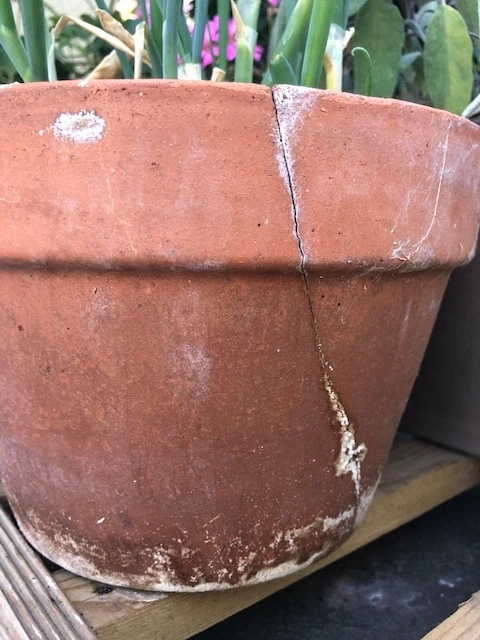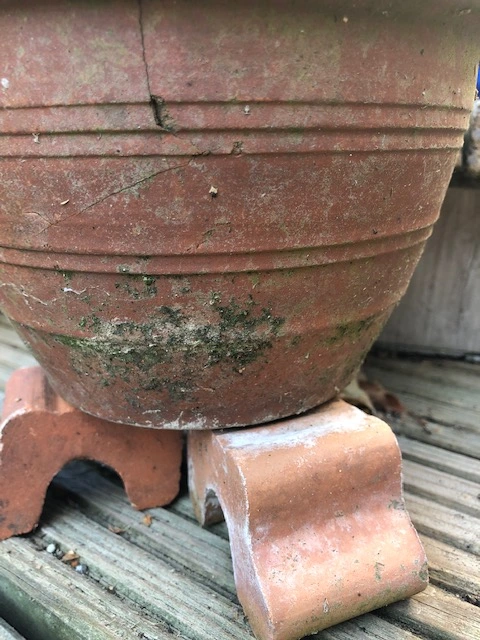Not too long ago, you bought a set of terracotta pots. You’re surprised to see they’re moldy already. The pots are otherwise in great condition, so you don’t want to throw them away, but they can’t stay as they are. How do you clean mold off terracotta pots?
To remove mold from terracotta pots, you can use household cleaning products, including vinegar, bleach, hydrogen peroxide, baking soda, and even sunlight. Moving your pots to a sunnier spot will prevent more mold, as will better air circulation.
In this guide to cleaning mold off terracotta pots, we’ll explain how your pots got moldy, what the different mold colors mean, and how to clean your pots of mold. We’ll also delve into preventative measures so your terracotta pots stay pristine in the future.
Let’s get started!

Why Does Mold Form on Terracotta?
That green residue (or perhaps it’s white or black) that you see on the outer surface of your new terracotta pots is indeed mold.
Why does mold form on terracotta?
The material is sort of a hotbed for mold considering how porous it is.
If you’re using your terracotta pots for outdoor plants, then the pots are regularly exposed to water each time you replenish your plants.
The pot will absorb the lion’s share of the water, keeping the pores full and moist.
Mold, as a fungus, prefers dark, humid, and wet environments. The inside of your terracotta pot meets all three criteria, and the outside of the pot ain’t so bad either, so mold can propagate and flourish.
White Mold on Terracotta Pots
Upon inspection, you realize that the pots are covered in white mold. It has a chunky, fuzzy texture, especially on the side or the rim of the pot.
Many forms of mold can have a white and fuzzy appearance, and many forms begin with this appearance before changing color and texture completely. If you do have white mold on your Terracotta pots, the most common forms are aspergillus, Cladosporium, and Penicillium.
Black Mold on Terracotta Pots
Black mold formation on outdoor surfaces is not uncommon, if the conditions are correct, it can grow almost anywhere. Pots that are being stored in warm and moist areas (such as in greenhouses) can develop mold over time. However, if they are stored outside, the likelihood of black mold or mildew buildup is reduced, as fluctuations in temperature and humidity will not permit the correct environment for mold to thrive and spread.
All mold is harmful if you have breathing issues such as asthma or allergies, but black mold can sometimes be toxic.
Green Mold on Terracotta Pots

Green mold develops in areas of low ventilation, high humidity, and dampness, aka your terracotta pots. The green hue is usually a distinct, sickly color, but it can be lighter or darker depending on the surface it grows on.
Algae occur on terracotta if the pot cannot dry sufficiently. Both algae and green mold can have a fuzzy texture, which makes them even more difficult to tell apart. However, in the majority of cases, the green “mold” you see will more than likely be green algae, especially if the pots have been stored outside.
Pots stored outside will not facilitate the environment that mold requires to breed and multiply, as there is plenty of ventilation, there are fluctuations in temperature and usually plenty of sunlight. This would be enough to kill most mold strains.
Is It Ok to Leave Mold on Terracotta Pots?
Now that you’ve identified the type of mold on your terracotta pots, of course, you’re going to have another question. Is it okay to leave the mold on the pots or must you remove it?
You don’t have to worry about mold affecting your plants, especially since it usually grows on the pot’s exterior.
As we mentioned earlier, it’s not ideal for people to breathe in mold. Then again, if your pots are outdoors and you don’t linger in the area for too long, then the health risks of mold are minimized.
Ultimately then, it comes down to whether you prefer your terracotta pots to look pristine or whether a bit of mold is okay.
Do keep in mind that what starts as a small amount of mold can quickly multiply and become a much bigger problem if the conditions for mold persist.
How to Clean Mold Off Terracotta Pots
You’ve decided that it’s for the best that you remove the mold from your terracotta pots. Per the intro, here are the methods you can use to do that.
How to Use Vinegar to Remove Mold from Terracotta Pots
Make a vinegar bath by combining water and white vinegar in a basin.
Before you plunk the pot in, be sure to wipe off any surface dirt and allow the pot to fully dry. Then soak it.
The terracotta pot should be left to soak for at least 15 minutes. If your pot is especially moldy, then it’s not a bad idea to let it sit in the basin overnight.
If you have a larger terracotta pot than one used for plants, then you’re going to need a bigger tub.
Of course, if you’d rather not lift and carry your terracotta pot (the material does break easily, after all), then you can always combine one part water with one part white vinegar in a spray bottle.
Using a clean sponge or scrubber, scour at the mold until it comes off. Rinse away the vinegar residue and allow your terracotta pot to fully dry.
How to Use Bleach to Remove Mold from Terracotta Pots
For heavy-duty cleaning, bleach will get the job done, removing all traces of mold on the terracotta pot.
Bleach can be irritating to the skin and mucus membranes. Working in a ventilated area or–even better–outside is best. You might still want to wear long sleeves, long pants, protective gloves, and goggles just to be safe.
Make sure you choose clothes that you don’t really care about. If you splash bleach on them, they’re ruined.
You need 20 parts water to one part bleach, so the mixture will be quite diluted. Transfer the fluid into a spray bottle.
Before you begin blasting the terracotta pot, it’s not a bad idea to dig your plants out from the root ball and store it elsewhere until you’re done using the bleach.
If bleach is bad for your skin and mucus membranes, you can imagine how injurious it can be to plants as well.
Mist the moldy areas of the pot with the bleach and water solution. You’ll need a scrubber or a sponge to remove the mold once it’s covered in the mixture. That’s why it’s a good idea to wear gloves.
You might have to follow this up with a second or even a third cleaning.
Be sure to rinse away the bleach residue with water each time and allow the pot to fully dry before getting it wet again.
How to Use Hydrogen Peroxide to Remove Mold from Terracotta Pots
Hydrogen peroxide is a less harsh cleaning agent than bleach, so you can use it on terracotta pots without having to remove your plants.
Most hydrogen peroxide that’s formulated for household use contains three percent hydrogen peroxide. That’s all you need to say goodbye to mold on your pots.
You can use hydrogen peroxide as is without the need to dilute it. To prevent the stuff from getting to unintended places, pour the hydrogen peroxide into a spray bottle.
Once hydrogen peroxide meets mold, you should hear an audible sizzling sound. This is the hydrogen peroxide getting to work. You’ll still have to scrub the mold away with a brush just to ensure it’s gone. Rinse the hydrogen peroxide residue with a garden hose or a spray bottle filled with water.
How to Use Sunlight to Remove Mold from Terracotta Pots
We saved what is by far the easiest method for last.
Sunlight is a natural enemy of mold since it’s not wet or damp. By dragging your terracotta pot out into the driveway or backyard where it can receive direct sun exposure, the mold on the pot will dry out and stop spreading, making it far easier to remove.
To keep your plants from scorching, it’s a good idea to take them out of the pot before placing them in direct sunlight.
Does Baking Soda Remove Mold from Terracotta?
You can indeed rely on baking soda to remove mold from terracotta. Here’s what to do.
- Take a tablespoon of baking soda and measure out a quarter of it. Dump that into an empty spray bottle.
- Fill the rest of the bottle with water and shake it up until you don’t see the baking soda powder floating around.
- Spray the mold on the terracotta pot.
- Using a stainless steel scrubber, rub at the moldy areas until the mold is lifted.
- Repeat as needed until the mold is gone.
- Rinse away the baking soda residue with water.
- Allow the terracotta pot to dry.
How to Prevent Mold on Terracotta Pots
Here are some pointers on preventing mold from forming on your terracotta pots in the first place.
Keep the Pots in a Sunny Location
As you’ll recall, sunlight stunts mold growth. If your pots sit in a sunny part of your yard or driveway, they’re a lot less likely to grow mold than if the pots are in the shade.
Don’t Overwater Your Plants
One of the fastest ways to invite mold is to saturate your plants in water. That’s just more hydration for the terracotta to absorb.
Your plants will be a lot healthier if you water them only when they need it.
Treat Mold as Soon as You Spot It
To reiterate our point from before, mold will continue to spread if you do nothing about it. As soon as you see even a fleck of mold on terracotta pots, get to work removing it.
Conclusion
Terracotta is prone to developing mold due to how highly porous the material is. Whether you see white, green, or black mold on your terracotta pots, you can use everyday cleaning products such as baking soda, hydrogen peroxide, bleach, or even sunlight to remove all traces of the mold!

